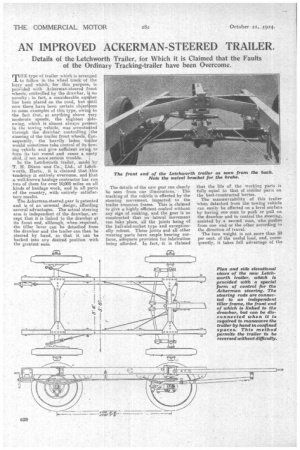AN IMPROVED ACKERMAN-STEERED TRAILER.
Page 12

Page 13

If you've noticed an error in this article please click here to report it so we can fix it.
Details of the Letchworth Trailer, for Which it is Claimed that the Faults of the Ordinary Tracking-trailer have been Overcome.
TFEE type of trailer which is arranged to follow in the wheel track of the lorry and which, for this purpose, is provided with Ackerman-steered front wheels, controlled by the drawbar, i no novelty ; in fact, a considerable lin ber has been placed on the road, but tntil now there have been certain objections to some examples of this type, owin to the fact that, at anything above tery moderate speeds, the slightest 'deswing, which is almost always pre nt in the towing vehicle, was accentu ted through the drawbar controlling, the steering of the trailer front wheels, onsequently, the heavily laden tr iler would sometimes take control of its owing vehicle and give sufficient swin to • turn its tail round and cause a n sty skid, if not more serious trouble.
• In the Letchworth trailer, made by T. H. Dixon and Co., Ltd., of Letchv orth, Herts., it is, claimed that this tendency is entirely overcome, and that a well-known haulage contractor has run two of them for over 10,000 miles on all kinds of haulage work; and in all parts of the country; with entirely satisfactory results.
The Ackerman-steered gear is patented and is of an unusual design, affording several advantages. The actual steering arm is independent of the drawbar, except that it is linked to the drawbar at its front end, although, when required, the tiller lever can be detached from the drawbar and the trailer can then be steered by hand, so that it can be backed into any desired position with the greatest ease. The details of the new gear can clearly he seen from our illustrations. The tracking of the vehicle is effected by the steering movement imparted to the trailer trunnion frame. This is claimed to give a highly efficient control without any sign of snaking, and the gear is so constructed that no lateral movement can take place, all the joints being of the ball-and-socket type and exceptionally robust. These joints and all other wearing parts have ample bearing surfaces, adequate provision for lubrication being afforded. In fact,it is claimed
that the life of the working parts is fully equal to that of similar parts on the best-constructed lorries.
The manceuvrability of this trailer when detached from the towing vehicle can easily be effected on a level siirfato by having one man to push or pull on the drawbar and to control the steering, assisted by a second man, who pushes from one end or the other according to
the direction of travel.. • The tare weight is not more than 50 per cent, of the useful load, and, consequently, it takes fall advantage of the reserve of power in the prime-mover. The trailer is made in two sizes—to carry loads of 3 tons and 5 tons respectively. The dimensions are as follow : 3-ton : Wheelbase, 6 ft. 6 ins. ; track, 5 ft. 6 ins.; height of frame loaded, 2 ft. 7 ins. ; length of frame, 10 ft. 6 ins. ; chassis weight, 22 cwt. ; tyres employed, 110 ram. for 720 mm.; price, £125. The 5-ton trailer has a wheelbase of 7 ft.
6 ins. The height of frame loaded is 2 ft. 81 ins., and the length of frarae 11 ft. 6 his. The chassis weight is 23i cwt., and the tyres used are 120 mm. for 720 mm. The price is £150. Tyres are included in each case.
Special attention has been paid to the matter of providing efficient brakes. The drums used on the rear wheels are of 14 ins. diameter and 2 ins. width. They are of the internal-expanding type, operated by easily adjustable wire rope, which is passed round a special semicircular compensating bracket carried on a centrally pivoted arm, the outer end of which is connected by a second wire rope to a screw gear at the rear end of the trailer, and di5nveniently situated on the inner side of the near-side frame member.
The brake compensating bracket also has a shackle, by which it can be connected to the lorry, affording a means for controlling the brake from the driver's peat.






























